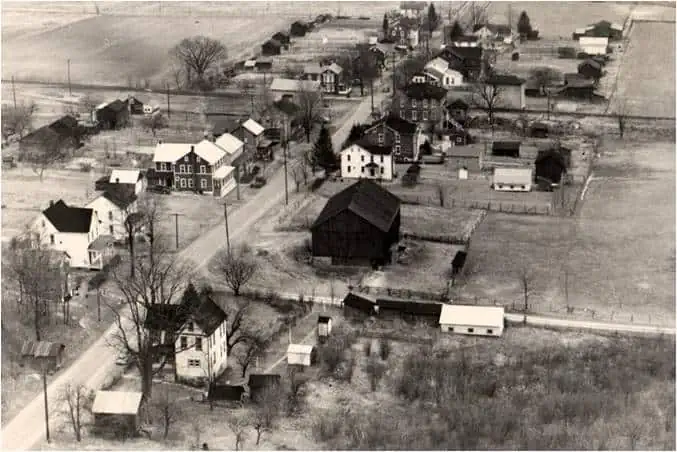Journey to the heart of Pennsylvania, where Raystown Lake, a breathtaking man-made wonder, unfolds. Nestled among the towering Allegheny Mountains, this lake is a tapestry woven from necessity and recreation. Discover the fascinating history hidden beneath its shimmering waters, where remnants of a forgotten past lie submerged. From its humble beginnings as a flood control measure to its transformation into a beloved playground for outdoor adventurers, Raystown Lake holds a wealth of captivating tales.
History of Raystown Lake, PA
The story of Raystown Lake begins in 1905, not with the U.S. Army Corps of Engineers, but with the entrepreneurial spirit of the Simpson family. Recognizing the potential of the Raystown Branch of the Juniata River, they constructed a hydroelectric dam, marking the first chapter in the area’s journey toward becoming the recreational haven it is today.
Fast forward nearly 70 years to 1973. The Army Corps of Engineers, acknowledging the region’s vulnerability to floods and the increasing demand for power, embarked on an ambitious project: the creation of Raystown Lake. This massive undertaking culminated in the completion of the Raystown Dam, forever changing the landscape and giving rise to a sprawling 8,300-acre lake boasting an impressive 118 miles of shoreline.
With the birth of Raystown Lake came an influx of recreation. Boating enthusiasts were drawn to its expansive waters, anglers cast their lines in pursuit of the lake’s bounty, and campers sought solace in the embrace of the surrounding wilderness.
Unlike many heavily developed lakes, Raystown Lake has retained a sense of pristine wilderness, largely due to the Army Corps of Engineers’ continued ownership of much of the surrounding land. This commitment to conservation has been instrumental in safeguarding the lake’s natural splendor.
However, the allure of Raystown Lake has sparked discussions about development. Balancing the preservation of its natural beauty with the growing demand for tourist amenities has become an ongoing dialogue, shaping the future of this Pennsylvania treasure.
What is the Story Behind Raystown Lake?
Before becoming the recreational paradise it is today, Raystown Lake was a vision driven by necessity. In the early 1900s, the need for electricity led to the construction of the first hydroelectric dam in 1905. This marked the beginning of a transformation that would see the landscape forever changed.
By 1973, the focus had shifted to flood control, prompting the Army Corps of Engineers to step in with the construction of the massive Raystown Dam. This ambitious project resulted in the creation of Raystown Lake as we know it: a sprawling 8,300-acre body of water with 118 miles of shoreline.
But the story of Raystown Lake is more than just concrete and water. It’s a tale of transformation, of progress and preservation, of the delicate balance between human ambition and the enduring power of the natural world. It’s a story still being written.
What are the Hidden Ruins at Raystown Lake PA?
Beneath the surface of Raystown Lake lies a hidden world, remnants of a time before the valley was flooded. When water levels drop, particularly during the winter months, ghostly reminders of the past resurface.
Among these submerged relics is the Brumbaugh homestead, once home to seven generations of the same family, including former Pennsylvania Governor Martin Brumbaugh. Though time and fire have taken their toll, the ruins offer a poignant glimpse into the lives lived there.
Another haunting reminder of the past is the sunken bridge of the Huntingdon and Broad Top Mountain Railroad. This once-bustling railway, a symbol of industry and progress, now rests silently beneath the lake’s surface, a testament to the passage of time.
Overlooking the lake and the former Brumbaugh homestead is Valley View Cemetery, the final resting place of Governor Martin Brumbaugh. This serene spot serves as a poignant reminder of the cyclical nature of life and the enduring power of history.
While these ruins offer a captivating glimpse into the past, they also represent just a fraction of what may lie hidden beneath the surface. Each drawdown offers the potential for new discoveries, adding another layer to the enigmatic allure of Raystown Lake.
What Happened at Raystown Lake?
Beyond the beauty and recreational opportunities, Raystown Lake holds a history marked by both triumph and sacrifice. The creation of the lake, while a testament to human ingenuity, came at a cost. Over 1,800 families were displaced, their homes and livelihoods submerged beneath the rising waters. Farms that had been part of the landscape for generations vanished, along with countless landmarks and a way of life.
The story of Raystown Lake is one of balancing progress with preservation, a theme that continues to play out today. The lake’s popularity as a recreational destination is undeniable, but it has also led to concerns about the impact of development on the environment and the lake’s serene character.
A prime example of this struggle occurred in 2015 when a large-scale resort and marina project was proposed. The plan was met with fierce opposition from those who feared it would irrevocably alter the character of Raystown Lake, ultimately leading to its rejection.
Raystown Lake stands as a testament to the complex relationship between humans and the natural world. It’s a place where the echoes of the past linger beneath the surface, a reminder of what was lost and what endures.
Is there a City Under Raystown Lake?
While the idea of a full-fledged city submerged beneath Raystown Lake might seem like something out of legend, the reality is a bit more nuanced. It’s not Atlantis, but there are remnants of a vibrant community that once thrived where the lake now shimmers.
During periods of drawdown, particularly in winter, these submerged echoes of the past become visible. Roads and bridges emerge from the receding waters, hinting at the network of paths that once connected this landscape. The ruins of the Brumbaugh homestead, a testament to generations of family history, stand as a stark reminder of the scale of transformation the area underwent.
Perhaps the most evocative relic of this submerged past is the sunken railroad bridge. Imagining a train chugging along where boats now glide paints a vivid picture of the changes that have occurred.
Though these remnants don’t constitute a “city” in the traditional sense, they do represent a lost community, one whose echoes continue to resonate through time. These submerged fragments of history add a layer of intrigue to Raystown Lake, inviting exploration and reflection on the passage of time and the indelible mark humans leave on the landscape.
Is Raystown Lake Safe to Swim in?
Raystown Lake, with its inviting waters and scenic beauty, is indeed a popular spot for swimming. However, as with any natural body of water, safety should always be a top priority.
The lake offers two designated public beaches – Seven Points and Tatman Run – which are open during the summer season. These areas are generally considered the safest for swimming, but it’s crucial to remember that lifeguards are not present.
Even when swimming in designated areas, it’s essential to be mindful of water conditions. Weather can change quickly, and even seemingly calm waters can harbor strong currents or unexpected hazards.
While the lake’s many rock formations may seem like tempting diving platforms, it’s best to resist the urge. You never know what lies beneath the surface.
Remember, a safe and enjoyable swimming experience at Raystown Lake starts with common sense. Be aware of your surroundings, follow posted rules and guidelines, and don’t hesitate to contact park rangers if you have any questions or concerns.
Are there Snakes in Raystown Lake?
Yes, snakes are a natural part of the ecosystem at Raystown Lake. While this might give some visitors pause, it’s important to remember that snakes generally prefer to avoid humans and are more likely to be a sign of a healthy ecosystem than a cause for alarm.
Of the 14 snake species found in the area surrounding Raystown Lake, only two are venomous: the copperhead and the timber rattlesnake. Both these species are relatively reclusive and would rather retreat than bite. Encounters are rare, but it’s always best to exercise caution when exploring areas where snakes might be present.
The remaining 12 snake species found in and around the lake are nonvenomous and play a vital role in the local ecosystem. Garter snakes, water snakes, black rat snakes, and worm snakes all contribute to keeping rodent populations in check, ensuring a healthy balance within the local environment.
Should you encounter a snake while visiting Raystown Lake, the best course of action is to simply admire it from a distance. Remember, you’re a visitor in their home. Give them space, and they’ll likely do the same for you.
What would Happen if Raystown Dam Broke?
While the Raystown Dam is a marvel of engineering designed to protect downstream communities, the hypothetical scenario of a dam break is a stark reminder of the forces at play. Such an event, though highly unlikely, would have catastrophic consequences.
An uncontrolled release of millions of gallons of water would unleash a torrent of destruction upon downstream communities. Homes, businesses, roads, and bridges would be at the mercy of the rushing floodwaters. Huntingdon County, with towns like Huntingdon, Mapleton, Mt. Union, Lewistown, and Shirleysburg all situated along the Raystown Branch, would bear the brunt of the devastation.
The economic toll of such a disaster would be immense. Businesses would face closure, homes would require rebuilding, and the cost of repairing or replacing critical infrastructure would be staggering. Beyond the immediate impact, the long-term economic health of the region would undoubtedly suffer.
Most importantly, the human cost of a dam failure at Raystown Lake is a sobering thought. The speed and force of the floodwaters would make escape difficult, potentially leading to loss of life. It’s a reminder that even in the face of seemingly insurmountable engineering, the power of nature should never be underestimated.
The Raystown Dam undergoes regular inspections and maintenance, and it’s designed to withstand even extreme weather events. However, the potential for failure, however remote, underscores the importance of emergency preparedness. Understanding evacuation routes and having a family emergency plan in place are crucial for anyone living or working downstream from the dam.
What is the History of Lake Sangchris?
Located in central Illinois, Lake Sangchris stands as a testament to the human ability to reshape landscapes. Created in 1964 by damming Clear Creek, this 3,022-acre reservoir serves a dual purpose: recreation and industrial utility.
While the idea of a lake created to cool a coal-fired power plant might not scream “natural beauty,” Lake Sangchris defies expectations. Its sprawling 120-mile shoreline, a jumble of twists, turns, inlets, and coves, is a haven for exploration and recreation.
Over time, the area surrounding the lake was designated as the Sangchris Lake State Recreation Area. This park, encompassing a diverse range of habitats, has become a hub for outdoor enthusiasts, offering everything from fishing and boating to camping, hiking, and wildlife viewing.
In 2013, a new chapter began for Lake Sangchris when management of the lake and the adjacent Kincaid Generating Station was assumed by the Illinois Department of Natural Resources and Vistra, respectively. This partnership signifies a commitment to ensuring the lake’s continued vitality as a recreational destination and a testament to the enduring appeal of this man-made wonder.
What is the Biggest Fish Caught Out of Raystown Lake?
Raystown Lake holds a special place in Pennsylvania fishing lore. It’s a place where anglers dream of landing a trophy fish, a lake with a reputation for producing some true giants. One such catch, etched into the annals of fishing history, solidified Raystown Lake’s status as a haven for striped bass enthusiasts.
In 1994, an angler’s dream became a reality when a striped bass weighing an astonishing 53 pounds and 12 ounces was pulled from the depths of Raystown Lake. This remarkable catch earned a place in the record books as the largest striped bass ever caught in Pennsylvania.
While this record-breaking striper might be the stuff of legends, Raystown Lake is no one-hit wonder. Largemouth and smallmouth bass thrive in its waters, providing ample opportunities for anglers to test their skills and maybe even reel in a personal best. Perch and catfish round out the lake’s diverse fish population, ensuring something for everyone, from seasoned pros to those casting a line for the very first time.
What is it about Raystown Lake that makes it such a prime spot for striped bass? Some experts suggest its depth, water quality, and abundant food sources create ideal conditions for these fish to thrive. The lake’s many coves, points, and underwater structures provide ample ambush points for these apex predators, adding an element of excitement to every cast.
So, while landing a state-record striped bass is a feat few will achieve, the potential is always there at Raystown Lake. Every trip to this angler’s paradise offers the chance to create lasting memories and maybe, just maybe, encounter one of the lake’s legendary giants.
What is the History of Jenkinson Lake?
Nestled amidst the rugged beauty of El Dorado County, California, Jenkinson Lake is a testament to human ambition and the enduring power of nature. But before the lake graced the landscape, the area was a very different place.
Imagine a vast, verdant meadow, carpeted in wildflowers each spring. This idyllic setting was once home to the Maidu and Miwok tribes, who relied on the land for sustenance, hunting game and gathering the bounty of the land.
The transformation from meadow to lake was the vision of Walter E. Jenkinson, a man determined to bring water to the region. His efforts culminated in the creation of the lake, though it was ultimately named after Robert Jenkins, a renowned bullfighter – an interesting twist of fate.
In more recent history, Jenkinson Lake faced the wrath of the 2021 Caldor Fire. This devastating wildfire swept through the region, leaving a trail of destruction in its wake. While the lake itself survived, its ecosystem was irrevocably altered. The fire’s intense heat scorched the surrounding soil, releasing carbon and other pollutants into the water, impacting water quality and disrupting the delicate balance of life within the lake.
The story of Jenkinson Lake, like the landscape it inhabits, is one of constant change. From its origins as a verdant meadow, through its transformation into a recreational haven, and its resilience in the face of natural disasters, Jenkinson Lake embodies the ebb and flow of time and the enduring connection between humans and the natural world.
Discover the fascinating history of Peter Wright anvils. Trace the evolution of hip-hop music through the iconic history of rap Justin Timberlake Jimmy Fallon. Explore the rich history and captivating exhibits at the renowned Elverhøj Museum of History & Art.
- SYBAU See You Baby Meaning: Gen Z Slang Evolves - July 1, 2025
- Unlock Your Inner Youth: Lifestyle Secrets for a Vibrant Life - July 1, 2025
- Decode SYBAU Meaning: Gen Z Slang Explained - July 1, 2025






